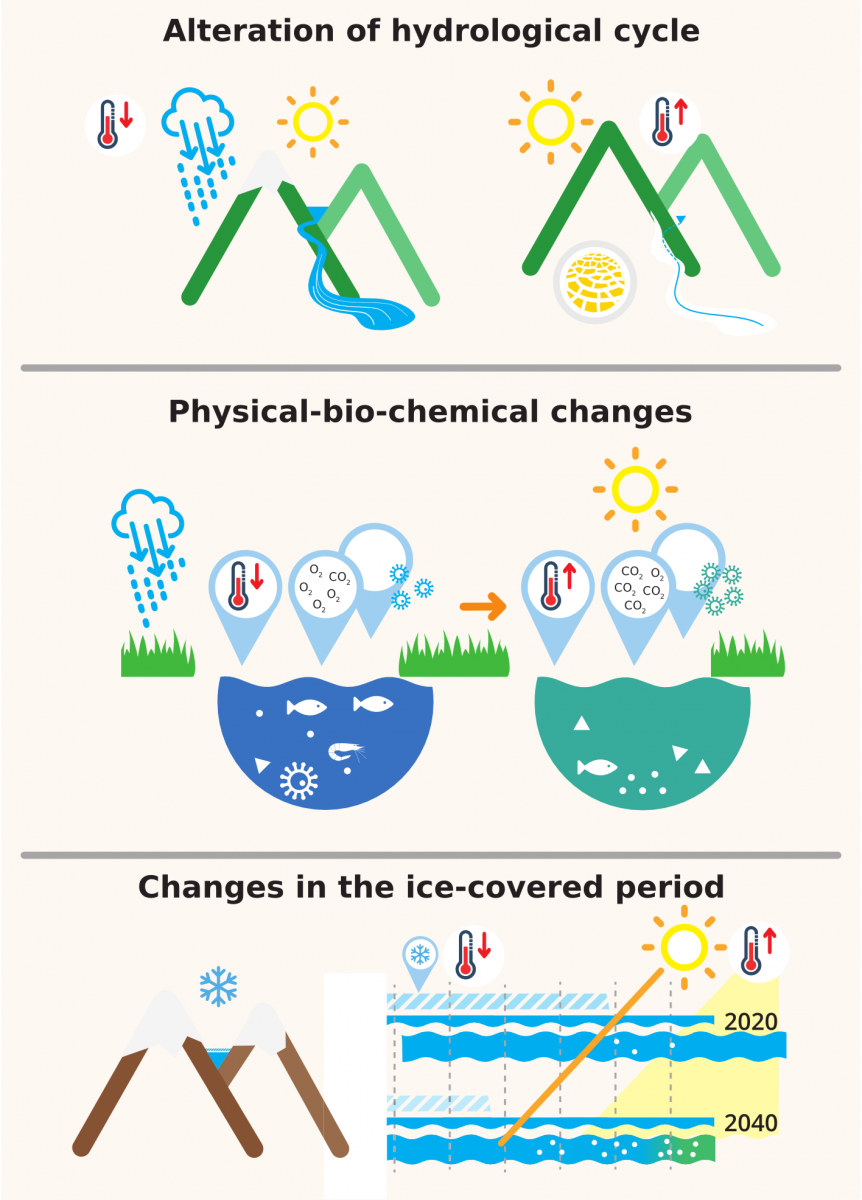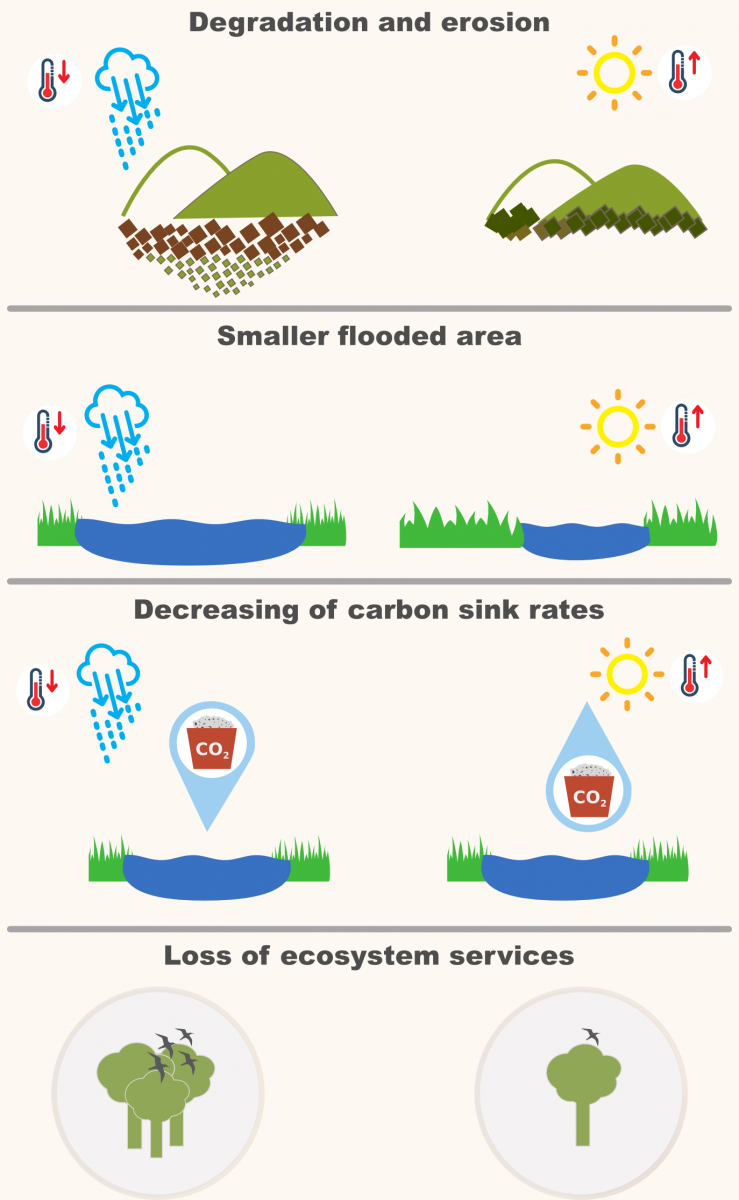High mountain lakes and peatlands are iconic elements of the Pyrenees landscape, which are very vulnerable to climate change and increasing anthropic pressure. In the Pyrenees more than a thousand high mountain lakes have been inventoried following different extension and altitude criteria, most of them located between an altitude of 2000 and 2500 m. In total there are 90 lakes with depths greater than 25 m, of which 47 exceed 40 m. Peatlands are ecosystems characterized by the accumulation of organic plant matter in conditions of water saturation. In the Pyrenees, most are of the "fen" type, feed by precipitation, surface water and / or groundwater. Topography, climatic and hydrological conditions condition their formation. The majority of the Pyrenean peatlands were generated after the deglaciation period and since then, have continued to accumulate organic matter until now. There is no complete inventory of peatlands in the Pyrenees, although they are less numerous than in other mountains with a more Atlantic climate.
The characteristics of these lakes and peatlands (high altitude, solar and UV radiation, ultraoligotrophy due to the lack of nutrients, very diluted waters, low temperatures, presence of an ice layer for several months, etc.) make them very sensitive to climatic changes (mainly changes in temperature and rainfall regimes, winds, etc). On the one hand they are "sentinels" of the changes that are happening in the Pyrenean territory, given their great sensitivity to climatic and environmental fluctuations and other alterations in their reception basins. On the other hand, they archive in their sediments the complex signals of the landscape, the aquatic system and the biological and abiotic processes and as well how they have evolved in the last centuries or millennia.
For millennia these ecosystems have sustained a complex biodiversity, served as carbon sinks and provided water resources, habitats for grazing and more recently for tourism purposes. During the last decades, the economy of many mountain areas has become increasingly dependent on tourist activities, mainly related to winter sports and summer hiking. Some of the unique elements of the high mountains such as glaciers, lakes, peat bogs and alpine tundra ecosystems are dynamic elements of local economies, with variable protection figures and conservation measures in the different Pyrenean territories. The high mountain is the granary of water, the power plant and the playground of all the Pyrenean territories, a region with growing needs for water and energy resources for agricultural and human consumption.
The conservation of these ecosystems within the framework of a sustainable development of the mountain ecosystem is, at same time, a challenge and an opportunity to become aware of the effects of global change in territories, considered as pristine.
Foreseeable impacts on lakes

The highest altitude areas of all the mountains in the world are areas where future scenarios of climate change indicate a higher incidence. The main expected impacts on high mountain lakes, peatlands and their reception basins are related to the alteration of their physical-chemical and biological characteristics in response to the variation in water availability and the increase in temperatures. At these elevations it is important not only the direct heating of the lake water, but also the duration of the ice cover of the lake and the snow mantle in the basin. Among other processes, are expected changes in the cycle of ice and thaw, in the type and abundance of certain communities and in the chemical composition of the water (alkalinity). Changes in the trophic status of high mountain lakes caused by climate change have been detected in most mountains of the world, associated with changes in the thermal regime and winds. The impacts of Climate Change in these Pyrenean ecosystems are mainly associated with changes in temperature regimes, and this effect is likely to accelerate markedly in the future. Some models predict that the surface water temperature of the lakes will increase by more than 10ºC during the 21st century, in line with available observations, exceeding the variations experienced in these lakes during the last 11700 years (Holocene).
We should not forget that in addition there are plant communities of wetlands and snowfields, as well as many Boreoalpine species at the limit of their distribution, associated with lakes and peatlands, which makes them especially vulnerable to any thermal change or rainfall pattern.
There are other indirect effects of climate change derived from the fusion of glaciers and permanently frozen soils (permafrost), in particular, the release of trace metals or persistent organic pollutants and the increased mobilization of organic matter and associated pollutants.
In addition, human activities impacts are superimposed on those caused by climatic variability. The lakes of the Pyrenees, despite their remote location, have suffered significant anthropic impacts in the last millennia: the deposition of heavy metals dates back to Roman times; deforestation in the reception basins of those located at medium altitude on which the greatest livestock pressure has been intense since medieval times. The introduction of fish is also an ancient practice (first references in the XIVth century). During the 20th century, the main impacts were the construction of hydroelectric dams and the increase of tourism and infrastructures related to winter and summer sports.
Foreseeable impacts on peatlands

The main expected impact on peatlands is their degradation due to the loss of flooded land. These changes will affect the capacity of these ecosystems to store carbon, regulate the quantity and quality of water and safeguard biodiversity, causing a loss of eco-systemic services.Hydrological changes will also affect both the accumulation and decomposition of peat and could increase the emission of greenhouse gases. The altitudinal ascent of the forest boundary as a result of higher summer temperatures can lead to forest expansion in open peatland areas, resulting in a reduction in albedo and a positive reinforcement in global warming. An increase of the torrentiality can increase the erosion of the peat bogs, that in addition can be amplified by their drainage and the over-grazing.
The combined effects of climate change with local changes in hydrology will have important consequences for the distribution and ecology of the plants and animals that inhabit or use peatlands. Human activities also increase the vulnerability of peatlands to climate change. In particular, drainage, burning or overgrazing will amplify carbon emissions.
Current challenges
Despite the remoteness of main human activities, the impact of climate change on lake systems and high mountain peatlands is difficult to distinguish from the effects of anthropogenic activities (tourism, nutrient deposition, use of water resources, etc…). Although the human impact may be decisive in some cases, the increase in temperature can put these high mountain systems in a situation of greater risk, by subjecting biological communities to a higher level of stress.
The lack of detailed information on the characteristics of these ecosystems (from detailed inventories to quantification of biogeochemical processes) and the lack of long time series prevents us from knowing the resilience of these mountain systems in the face of the pressures of climate and anthropic change.
To manage the effects of climate change - and human activities - on the high mountain lakes and peatlands of the Pyrenees, we need long-term monitoring strategies that allow us to better understand the complex processes that take place in these ecosystems and to reduce the uncertainties of the models, and thus, to be able to improve our capacity to carry out right policies of sustainable management.
PYRENEAN CLIMATE CHANGE OBSERVATORY
Avenida Nuestra Señora de la Victoria, 8
22.700 - Jaca
Huesca - España
+34 974 36 31 00
info_opcc@ctp.org




